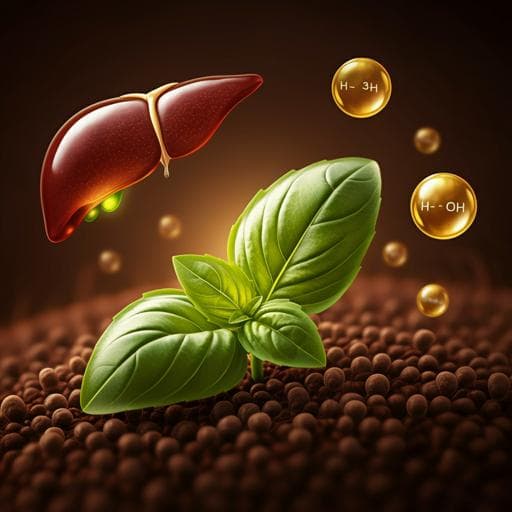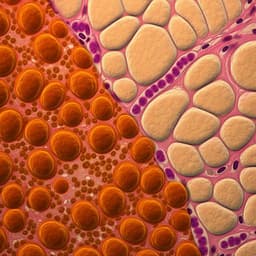
Medicine and Health
High-fiber basil seed flour reduces insulin resistance and hepatic steatosis in high-fat diet mice
C. Farías, C. Cisternas, et al.
Discover how a fiber-rich fraction of partially defatted basil seeds can improve insulin resistance and liver health in high-fat diet-fed mice. This promising study conducted by Camila Farías, Camila Cisternas, Angie Caicedo, Lorena Mercado, Rodrigo Valenzuela, Héctor Calderón, Alejandra Espinosa, L. A. Videla, and Loreto A. Muñoz reveals significant therapeutic benefits worth exploring.
~3 min • Beginner • English
Introduction
Insulin resistance (IR) affects 10–30% of the population and is a key driver of type 2 diabetes mellitus and metabolic syndrome, often accompanied by non-alcoholic fatty liver disease (NAFLD). Excess intake of simple carbohydrates and saturated fat promotes ectopic lipid accumulation and proinflammatory adipokines, impairing glucose and lipid metabolism in insulin-sensitive tissues. NAFLD, ranging from simple steatosis to non-alcoholic steatohepatitis, is prevalent (~25% globally) and linked to IR. Dietary fiber has been proposed as a protective factor due to its prebiotic properties, modulation of gut microbiota and short-chain fatty acids (SCFAs), and effects on lipid and glucose metabolism. This study aimed to test whether a fiber-rich fraction of partially defatted basil seed flour (BSF) can attenuate IR and hepatic steatosis in high-fat diet (HFD)-fed mice, and to assess its impact on tissue polyunsaturated fatty acid profiles and fecal SCFA production, compared with oat flour (OAF) as a fiber control.
Literature Review
Prior work links higher dietary fiber intake with improved metabolic health, including body weight regulation, lipid lowering, and improved insulin sensitivity. Fiber can act as a prebiotic, altering gut microbiota composition and activity to increase SCFAs, which influence host metabolism. Fiber-rich by-products (e.g., chia pressing fractions) have high fiber content and functional properties. Basil seeds have been reported to contain substantial dietary fiber and bioactive components, including α-linolenic acid (ALA) and antioxidant/α-amylase inhibitory peptides. n-3 PUFAs (ALA and its longer-chain products EPA/DHA) modulate gene expression through PPAR-α, inhibit NF-κB signaling, and can generate pro-resolving mediators (resolvins). Previous animal studies with fermentable fibers (e.g., gum acacia, inulin, artichoke fiber) showed reduced adiposity, improved IR, and lower serum triglycerides and cholesterol. Oat β-glucans are known to lower LDL cholesterol and may improve gut barrier integrity by upregulating tight junction proteins and suppressing TLR4–NF-κB signaling. However, the health-promoting potential of basil seed oil by-products (fiber-rich fractions) has been underexplored.
Methodology
Study design: Male C57BL/6J mice (n = 28) were randomized into four groups (n = 7/group): (1) control diet (CD; 10% kcal from fat), (2) high-fat diet (HFD; 60% kcal from fat), (3) HFD + basil seed flour (BSF), and (4) HFD + oat flour (OAF). After 10 weeks on CD or HFD, two HFD groups were supplemented for 4 weeks with fiber-rich BSF or OAF (20% inclusion, calculated to approximate WHO 25 g/day human fiber recommendation). Mice had ad libitum access to food and water, with controlled environment and 12 h light–dark cycles. After 14 weeks total, mice were fasted 12 h and anesthetized; blood and tissues (liver, brain, epididymal fat) were collected, snap frozen (−80 °C), with a portion of liver fixed for histology. Ethics approval was obtained from the University of Chile (protocol CBA #1118 FMUCH).
BSF preparation and characterization: Basil seeds were cold-pressed (Komet DD85G) to obtain expeller pellets, which were ground (RETSCH ZM-200) and dry-fractionated through a 212 µm sieve (RETSCH RS-200) to obtain the fiber-rich fraction. Proximate composition was determined by AACC/AOAC methods: ash (AACC 08-03), protein (Kjeldahl), moisture (105 °C oven), total/soluble/insoluble fiber (AOAC 991.43). Total lipids were extracted (Bligh & Dyer) and quantified gravimetrically; fatty acids were converted to FAMEs (boron trifluoride-methanol) and analyzed by GC-FID (Agilent 7890A; HP-88 column) using C23:0 internal standard.
Outcomes and analyses:
- Intake and anthropometrics: Daily body weight, diet and water intake; energy and macronutrient intakes calculated.
- Metabolic parameters: Fasting serum glucose (mg/dL), insulin (µU/mL); HOMA-IR calculated as [insulin × glucose (mmol/L)]/22.5. Serum TG, total cholesterol, HDL, and LDL (Friedewald formula) by strips (KENSHIN-2).
- Hepatic steatosis and damage: Histology (H&E) scored for steatosis (macro- and microvesicular); hepatic fat (g/100 g), TG and cholesterol (mg/g tissue) by enzymatic kits; serum AST, ALT, and GGT (U/L) by strips.
- Oxidative stress and antioxidant status: Hepatic TBARS (µM MDA/mg protein), F8-isoprostanes (pg/mg tissue), and protein carbonyls (nmol/mg protein) by ELISA/colorimetry; hepatic GSH, GSSG, and GSH/GSSG ratio by enzymatic recycling (DTNB) at 412 nm.
- Specialized pro-resolving mediators: Hepatic RvD1 and RvD2 by ELISA (pg/g tissue).
- Gene expression (liver): mRNA for PPAR-α, CPT1α, SREBP-1c, FAS, NF-κB-1, TNF-α, IL-1β, and IL-6. RNA extracted with TRIzol, DNase-treated; cDNA synthesized and quantified by TaqMan qPCR on Agilent AriaMx; normalization to GAPDH; fold change by 2^−ΔΔCt.
- Fatty acid profiles: Total fat and FA composition (GC-FID) in liver, epididymal adipose tissue, erythrocytes, brain, and stool; results expressed as % mol of total FA.
- Stool analyses: Moisture (%), pH, total fat (g/100 g), and SCFAs (acetic, propionic, butyric; mM/g) by GC-FID using 2-ethyl butyric acid internal standard.
Statistics: Proximate analyses reported as mean ± SD; one-way ANOVA with Tukey post hoc (p < 0.05). Animal data were non-normally distributed; results as median (IQR). Shapiro–Wilk for normality; Kruskal–Wallis with Dunn’s multiple comparisons (p < 0.05).
Key Findings
Composition of flours: BSF was markedly richer in total dietary fiber than oat flour (OAF): 64.69 ± 2.86 vs 11.72 ± 0.06 g/100 g. BSF had higher protein (20.24 ± 0.39 vs 12.56 ± 0.10 g/100 g) and lower energy density (267.5 vs 457.2 kcal/100 g). BSF was richer in PUFAs (3.24 vs 2.61 g/100 g), especially ALA (2.31 vs 0.15 g/100 g), while OAF had more MUFA (2.67 vs 0.41 g/100 g).
Intake and body weight: Energy intake was higher in HFD groups versus CD (median 14.15 vs 10.39 kcal/day). Final body weight increased with HFD [46.80 g (44.8–50.3)] versus CD [27.10 g (25–28.9)], and was modestly lower with BSF [44.30 g (43.2–45.0)] than HFD; OAF was similar to HFD [46.50 g (45.3–47.8)]. Liver weight was reduced by BSF vs HFD [2.14 g (1.52–2.26) vs 2.72 g (2.38–3.52)]. Fecal fat was elevated by HFD [19.25 g/100 g (18.25–21.38)] and reduced with BSF [11.50 (10.25–12.0)].
Glycemic and lipid profile: HFD induced higher fasting glucose, insulin, and HOMA-IR (Fig. 1). Both BSF and OAF reduced glycemia and insulinemia versus HFD, improving HOMA-IR; OAF showed the strongest glucose reduction, with BSF also effective. BSF and OAF lowered serum triglycerides versus HFD; total cholesterol differences were significant mainly between CD and HFD. HDL and LDL were reduced in BSF and OAF versus HFD, with BSF exerting greater LDL and total cholesterol attenuation.
Inflammation (plasma): HFD elevated TNF-α, IL-6, and IL-1β. BSF significantly decreased TNF-α and IL-6 toward CD levels; OAF more effectively reduced IL-1β compared with HFD.
Liver steatosis and injury: HFD induced micro- and macrovesicular steatosis with high histological steatosis scores. Both BSF and OAF attenuated steatosis; BSF had the lowest hepatic fat content (g/100 g) and significantly reduced hepatic TG and cholesterol vs HFD. Serum AST/ALT were elevated in HFD and OAF groups vs CD; BSF normalized transaminases to CD-like values, indicating less hepatocellular injury.
Hepatic fatty acids: HFD increased total MUFAs and decreased n-3 PUFAs vs CD. BSF raised hepatic ALA [0.70% (0.56–0.84) vs 0.31% (0.25–0.36) in HFD] and DHA [3.05% (2.73–3.32) vs 1.98% (1.85–2.28) in HFD], and increased EPA [0.71% (0.45–0.79) vs 0.38% (0.34–0.44) in HFD]. BSF improved liver total n-3 PUFA [4.27% (4.15–5.05)] vs HFD [2.75% (2.5–3.18)] and lowered n-6/n-3 ratio [4.12 vs 5.81].
Other tissues: In epididymal adipose tissue, ALA was higher in BSF [1.08% (0.92–1.15)] and CD [0.84% (0.81–0.87)] vs HFD [0.55% (0.23–0.65)]. Erythrocytes showed higher total n-3 PUFA with BSF [6.06% (4.95–7.86)] vs HFD [3.45% (2.84–4.57)], and lower n-6/n-3 ratio [2.89 vs 4.60]. Brain ALA increased only in BSF [0.09% (0.07–0.15)] vs 0.00% in other groups; DHA remained similar across groups. Stool from BSF and OAF groups showed increased SFAs and PUFAs versus HFD, consistent with reduced absorption of saturated fats.
Oxidative stress, antioxidant status, and resolving mediators: HFD elevated hepatic TBARS, F8-isoprostanes, and protein carbonyls. BSF normalized TBARS and reduced F8-isoprostanes and protein carbonyls vs HFD and OAF. HFD increased hepatic GSH and GSSG (likely compensatory); supplemented groups showed lower levels; GSH/GSSG ratio was higher in HFD and OAF than CD, while BSF trended to normalization. BSF increased hepatic resolvins (RvD1/RvD2), indicating enhanced pro-resolving capacity.
Gene expression (liver): PPAR-α mRNA was significantly reduced in HFD and OAF vs CD, but maintained with BSF (similar to CD). CPT1α decreased in HFD, less so in supplemented groups. Lipogenic and inflammatory genes (SREBP-1c, FAS, NF-κB-1, TNF-α) were upregulated in HFD and significantly attenuated by BSF; SREBP-1c and IL-1β showed smaller or nonsignificant attenuation with BSF.
SCFAs and stool characteristics: Total fecal SCFAs increased significantly with BSF versus HFD; acetic > propionic > butyric acids predominated. Stool moisture increased with BSF and OAF; stool pH was modestly lower in HFD groups, consistent with SCFA production. Collectively, SCFA enhancement and altered stool fat support improved gut milieu and reduced fat absorption with fiber supplementation.
Discussion
Supplementation with a fiber-rich basil seed flour (BSF) robustly mitigated HFD-induced insulin resistance, hepatic steatosis, and systemic inflammation. Mechanistically, BSF’s high total and insoluble fiber likely reduced intestinal lipid absorption and increased bile acid excretion, contributing to lower circulating TG and LDL, higher fecal fat, and decreased hepatic lipid accumulation. The ALA-rich lipid fraction in BSF increased hepatic and erythrocyte n-3 PUFAs (EPA/DHA), shifting the n-6/n-3 balance, upregulating PPAR-α and CPT1α, and downregulating lipogenic (SREBP-1c, FAS) and inflammatory (NF-κB-1, TNF-α) pathways, thereby enhancing β-oxidation and attenuating de novo lipogenesis and inflammation. Increased resolvins (RvD1/RvD2) with BSF support a pro-resolving anti-inflammatory milieu. The elevation of fecal SCFAs with BSF suggests prebiotic activity that may improve intestinal barrier function, reduce luminal pH, modulate immune responses, and further enhance hepatic lipid oxidation via SCFA-driven signaling. While oat flour (OAF) improved several parameters (glycemia, lipids, SCFAs), BSF generally elicited greater benefits, likely due to the combination of very high fiber, ALA content, and additional bioactive peptides with antioxidant and α-amylase inhibitory activity. These integrated effects address the study’s hypothesis by showing that BSF can reverse key metabolic disturbances of HFD feeding across multiple tissues and pathways.
Conclusion
A fiber-rich fraction of partially defatted basil seeds (BSF) effectively attenuated HFD-induced insulin resistance, hepatic steatosis, oxidative stress, and inflammation in mice, while improving lipid profiles, increasing tissue n-3 PUFAs (liver, adipose, erythrocytes), and enhancing fecal SCFA production. Oat flour produced benefits but was generally less effective than BSF. These findings highlight the therapeutic potential of BSF, a revalorized by-product of basil oil production, as a functional fiber and ALA source for managing IR and reversing hepatic steatosis. Future work should include characterization and quantification of residual polyphenols and other bioactives in BSF, detailed gut microbiota analyses to link SCFA shifts with taxa changes, dose–response and time-course studies, and translational trials in humans to confirm efficacy, safety, and mechanisms.
Limitations
The study used a murine model (male C57BL/6J) with relatively small group sizes (n = 7) and a 4-week supplementation period following HFD induction, which may limit generalizability to humans and longer-term outcomes. Gut microbiota composition was not profiled, precluding direct linkage of SCFA changes to microbial taxa. While BSF contains multiple bioactive components (fiber, ALA, peptides), the specific contribution of each was not isolated. Only male mice were studied, so potential sex-specific responses were not assessed. Some outcomes were presented without exact numeric values from figures, and resolvins were measured only in liver tissue.
Related Publications
Explore these studies to deepen your understanding of the subject.







